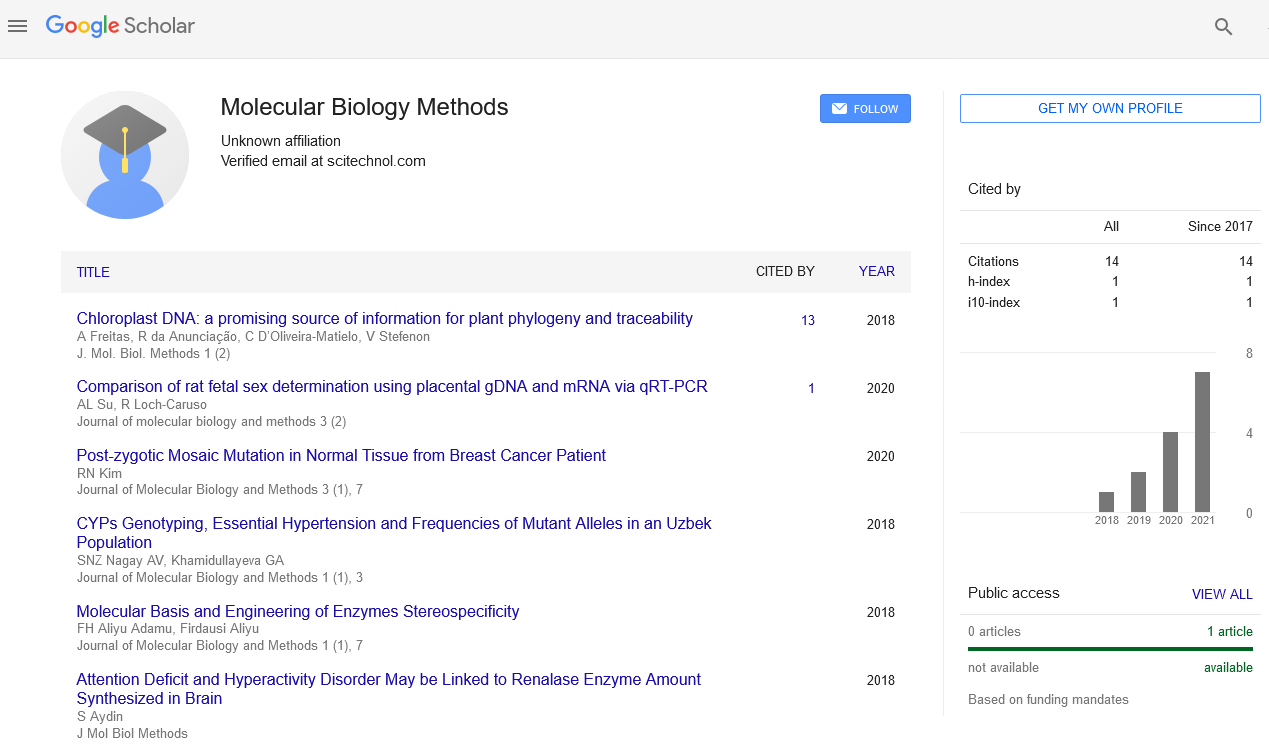Opinion Article, J Mol Biol Methods Vol: 4 Issue: 6
Protein Synthesis is a Specialized Cell Structure and Function
Riki Ogasawara*
Department of Life Science and Applied Chemistry, Nagoya Institute of Technology, Nagoya, Japan
- Corresponding Author:
- Riki Ogasawara
Department of Life Science and Applied Chemistry, Nagoya Institute of Technology, Nagoya, Japan
E-mail: ogasawara.riki@nitech.ac.jp
Received date: November 03, 2021; Accepted date: November 18, 2021; Published date: November 25, 2021
Keywords: Protein Synthesis
Description
Cell-free protein synthesis has been used for decades in many areas of analysis. It helped elucidate the mechanism of protein synthesis and has made experimental proteins to any our information of protein structure and organic chemistry. Recently abundant work has been done to expand the vary of applications for noncellular systems. A broad vary of product is made, together with membrane proteins, giant multimeric complexes, and proteins containing non-native amino acids. Many ways for protein engineering and evolution create use of noncellular expression, and it's getting used to translate our genomic information into useful proteins. Several of the challenges of business scale noncellular expression are addressed, and also the system is prepared for producing pharmaceutical proteins. Very soon, clinical trials can begin with medical specialty created by noncellular technology.
Protein Synthesis
Protein synthesis, that is, the method of mRNA translation, consists of three steps initiation, elongation, and termination. These steps involve ribosomes and a number of other cytoplasmic factors that play necessary roles throughout this method. The cell organ may be an advanced cell organ and consists of two subunits, the 50 S and 30 S units. Together, they organize the formation of a fancy initiation part between f-Met-charged aminoacyl-tRNA and mRNA transcript [1]. This method involves many different initiation factors. Aminoglycosides and antibacterial are one among the foremost numerous categories of antibiotics broad spectrum, that target this machinery and inhibit protein synthesis in microorganism. Supported the target they opt for inhibition both the 50 S inhibitors and also the 30 S inhibitors they're divided into two categories of those antibiotics [2].
Novel Functions
Protein synthesis, it's become clear that AARSs are concerned in many different cellular pathways. Some AARSs regulate their own transcription and translation, whereas others contribute to conjunction activities in mitochondria. Nuclear aminoacylation of tRNAs by foreign AARSs is assumed to be a top quality management mechanism to confirm that solely mature, absolutely active tRNAs ar free expeditiously to the living substance for protein synthesis [3]. Programmed death apoptosis conjointly seems to own associate degree AARS component-human tyrosylâ??tRNA synthetase is proteolytically cleaved into 2 polypeptides with distinct protein activities, despite the shortage of such activity within the full-length TyrRS. It’s doubtless that in time more travel functions of AARS are known.
Proline may be a proteogenic organic compound and accumulates each underneath stress and non-stress conditions as a helpful substance in plants. Recent discoveries entails that aminoalkanoic acid plays a vital role in plant growth and differentiation across life cycle. It’s a key determinant of the many cell membrane proteins that plays necessary roles in plant development. The role of extensins, arabinogalactan proteins and hydroxyproline- and proline-rich proteins as necessary elements of cell membrane proteins that play polar roles in cell membrane signal transduction cascades, plant development and stress tolerance is mentioned. Molecular insights also are provided here into the plausible roles of aminoalkanoic acid transporters modulating key events in plant development. Additionally, the roles of aminoalkanoic acid throughout seed organic process transitions together with storage protein synthesis are mentioned [4].
Protein synthesis presumptively emerged as a changed kind of self-replication. Apparently, peptides existed before ribosomes and were synthesized singly by specific ribozymes. As a result of 1st peptides were doubtless short and enclosed solely some varieties of aminoacids, their useful capacities were restricted. The biological process fate of peptides modified once they were wont to assist the self-replication of RNA. As a result, activity supported not solely self-replication of the RNA itself, however conjointly the assembly of helper peptides [5]. Above all, peptides became longer and enclosed a lot of specific sequence of aminoacids. The variety of animoacids exaggerated in evolution, and particularly necessary was the emergence of aminoacids that are presently found in catalytically active parts of proteins essential amino acid, cysteine, serine, treonine, aspartate, histidine, and thyrosine. The primary four of them are rather straightforward and doubtless appeared earlier in evolution that the latter. The evolution of peptide-assisted RNA replication conjointly enclosed the emergence of economical chemical process of chemical bond formation and RNA for transporting aminoacids. This hypothesis is supported by the very fact that the ribosomal RNA of microorganism E. coli carries remnants of the whole set of tRNAs for all aminoacids beside fragments of secret writing sequences for ribosomal proteins, polymerases, ligases, synthetases, and phosphatases. Thus, ribosomal RNA apparently originated from an aboriginal ordering that encoded a self-organizing and self-replicating molecular assembly.
References
- Carlson ED, Gan R, Hodgman CE, Jewett MC (2012) Cell-free protein synthesis: Applications come of age. Biotechnol Adv 30:1185-1194.
- Buchner E (1897) Alcoholic fermentation without yeast cells. Ber Dtsch Chem Ges 30: 1110-1113.
- Matthaei H, Nirenberg MW (1961) The dependence of cell-free protein synthesis in Escherichia coli upon RNA prepared from ribosomes. Biochem Biophys Res Commun 4: 404-408.
- Sawasaki T, Ogasawara T, Morishita R, Endo Y (2002) A cell-free protein synthesis system for high-throughput proteomics. Proc Natl Acad Sci USA 99: 14652-14657.
- Rosenblum G, Cooperman BS (2014) Engine out of the chassis: Cell-free protein synthesis and its uses. FEBS Lett 588 261-268.
 Spanish
Spanish  Chinese
Chinese  Russian
Russian  German
German  French
French  Japanese
Japanese  Portuguese
Portuguese  Hindi
Hindi 